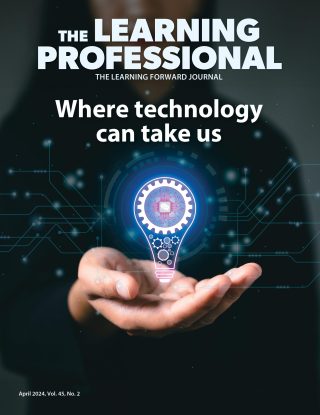Position: Deputy director of schools, Loudon County Public Schools, Tennessee
In education: 18 years
Learning Forward member since: 2015
Learning Forward origin story: I became a Learning Forward member because I wanted access to professional expertise that would stretch my thought processes. I’m in a small- to medium-sized rural district that is very innovative, and I was seeking to connect with leaders in a similar position. Although I felt like we were a leader in professional development, I wanted to strengthen our professional development even more and look at how the process could be refined to a point that we are able to offer teachers a highly individualized professional development experience.
How Learning Forward helped him: We have been part of Learning Forward’s Redesign PD Community of Practice, and our problem of practice has focused on improving the coherence and relevance of our professional development. The collaboration with Learning Forward and its members has given me a better insight on refining our professional development within the district, as well as my own professional development.
Michael Garren has a joke at the ready when he’s asked why he left a career as a civil and environmental engineer to become an educator: “Summers off!” In truth, the reason Garren switched careers is more heartfelt. “I made this switch because I’ve always loved working with kids, and there is something really special about giving a child a better opportunity to be successful in life.” Now, after years in the classroom and working as an instructional supervisor — as well as earning a master’s degree in education and an education specialist degree in supervision and administration — Garren leads a small but innovative professional learning team in Loudon County Public Schools (student population about 5,000).
What is your greatest professional learning challenge day to day?
Making sure that the professional development we deliver to teachers is beneficial to them and worth the investment of resources we are making. Examining our professional development practices regarding quality, relevance, and coherence has provided the opportunity to look at where our district has been and where we hope to move. I have also investigated how best to communicate this to all stakeholders in the process for them to feel informed and invested.
What’s your primary long-term challenge?
Differentiating professional development opportunities for teachers to make their professional learning more individualized and meaningful while making it coherent and relevant to the district’s vision.
You’ve said you believe Loudon County is on the leading edge of professional learning innovation. How so?
Essentially, we’re not afraid to take risks, and we try to stay on the cutting edge of new strategies or new initiatives if the state wants to pilot something. With our size — we’ve got about 400 teachers — we can make sure we’re communicating with everyone. Right now, we’re doing an initiative dealing with early literacy, and then we’re doing one systemwide dealing with effective planning strategies for teachers. I’ve been able to pull every teacher in the district out. Today I’ll pull all the kindergarten teachers. Well, that’s about 25 teachers. Then tomorrow, I’ll pull all the 1st grade, then I’ll pull all the 2nd, all the 3rd. I pulled all the teachers K through 12 out already this year to go through our effective planning. When we do an initiative, we’re able to do that with everybody. Everybody’s getting the same message. Everybody’s on the same page.
The sense of cohesion runs up and down the org chart, true?
Yes. All of our district supervisors plan and collaborate together as a team when developing and facilitating professional learning opportunities. This creates a more coherent experience for administrators and teachers and allows the district to maximize its various funds toward the vision of the district. Our district is just the right size to be able to train all teachers in what we feel are important initiatives and not rely on a train-the-trainer model in schools. This makes the training more coherent and relevant, and it increases the fidelity exponentially. There is a culture of not only excellence but one of collegiality and family that exists in our district.
What drives that culture?
At least in part it’s driven by the unity and vision of the district office. Our district needs to improve on differentiating professional learning for teachers to maximize their strengths and enhance their areas of challenge. However, with the positive culture already in place, we feel we are poised to take on this challenge with great success.
How do you overcome skepticism or stereotypes of sit-and-get style professional learning?
I think you give teachers what they need, make it engaging, and help them see the relevance of their training to their everyday work. Teachers inherently want to improve their practice, and if you provide them with opportunities that are relevant and engaging, then that will overcome any skepticism.
Since you got this job in 2011, you’ve used instructional coaching as a tool to help them improve.
My second year here, I started an instructional coaching program. There weren’t any instructional coaches in the district, and I started with an English language arts instructional coach. Then the next year, I added a math instructional coach, then another English language arts coach, then a special education instructional coach. I went from zero coaches to four coaches in four years. And we provide similar training to all principals and assistant principals, so they know, “This is the training that we’ve provided your teachers. This is what you need to know to support that effort and what you need to look for to make sure this is taking place in the classroom.” I see a lot of places you’ve got that disconnect where you do a lot of teacher training, but then your admin is still running kind of out on their own. Not here.
How do you tie student achievement to professional learning design and implementation?
This is a challenge in professional learning because there are a multitude of factors that impact student achievement. I believe designing professional learning that is sound and based on good practice, relevant to teachers’ needs and vision of the district, while allowing teachers to produce a product that they feel will improve their instruction will lead to gains in student achievement. You overcome this challenge in the same way you overcome sit-and-get skepticism: Make your professional learning meaningful for teachers, make it relevant, and provide them the opportunity to leave the training with actionable steps or products.
What new initiatives did you implement this past year?
We had two primary focuses: One, we implemented the use of a professional learning rubric to evaluate all professional learning opportunities before offering them to increase the coherence, relevance, and quality. This is supplemented by a newly designed survey instrument to gather teachers’ perceptions of the offering as well. The data derived from these two processes will help drive our professional learning offerings and determine the level of effectiveness in the teachers’ eyes of the professional learning.
Two, the district is focused on effective lesson planning strategies for all teachers that particularly highlight the thought processes behind planning. We engaged in some instructional professional development with our administrators as well to more effectively look for evidence of this planning in instruction so that teachers can be provided with any support they need.
Has your feedback been positive on these?
In the spring, one of the questions on the survey is, “How do you think the professional development is aligned to the district goals and vision? How do you think that alignment is with the professional development that you’ve got?” We were around 70% to 72% positive last spring. Now, we’re at 92%. I think that is, No. 1, because our professional development is more aligned and more cohesive, and No. 2, we’ve done a better job communicating what our goals and vision for the district are. That feedback let us know we were doing something right.
Learning Forward is the only professional association devoted exclusively to those who work in educator professional development. We help our members plan, implement, and measure high-quality professional learning so they can achieve success with their systems, schools, and students.
Recent Issues
EVALUATING PROFESSIONAL LEARNING
February 2024
How do you know your professional learning is working? This issue digs...
TAKING THE NEXT STEP
December 2023
Professional learning can open up new roles and challenges and help...
REACHING ALL LEARNERS
October 2023
Both special education and general education teachers need support to help...
THE TIME DILEMMA
August 2023
Prioritizing professional learning time is an investment in educators and...












